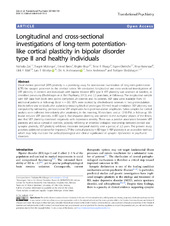| dc.contributor.author | Zak, Nathalia | |
| dc.contributor.author | Moberget, Torgeir | |
| dc.contributor.author | Bøen, Erlend | |
| dc.contributor.author | Boye, Birgitte | |
| dc.contributor.author | Waage, Trine Rygvold | |
| dc.contributor.author | Dietrichs, Espen | |
| dc.contributor.author | Harkestad, Nina | |
| dc.contributor.author | Malt, Ulrik Fredrik | |
| dc.contributor.author | Westlye, Lars Tjelta | |
| dc.contributor.author | Andreassen, Ole Andreas | |
| dc.contributor.author | Andersson, Stein | |
| dc.contributor.author | Elvsåshagen, Torbjørn | |
| dc.date.accessioned | 2019-05-31T12:05:06Z | |
| dc.date.available | 2019-05-31T12:05:06Z | |
| dc.date.issued | 2018-05-24 | |
| dc.Published | Zak N, Moberget T, Bøen E, Boye B, Waage TR, Dietrichs E, Harkestad N, Malt UF, Westlye LT, Andreassen OA, Andersson S, Elvsåshagen T. Longitudinal and cross-sectional investigations of long-term potentiation-like cortical plasticity in bipolar disorder type II and healthy individuals. Translational psychiatry. 2018;8:103 | eng |
| dc.identifier.issn | 2158-3188 | |
| dc.identifier.uri | https://hdl.handle.net/1956/19830 | |
| dc.description.abstract | Visual evoked potential (VEP) plasticity is a promising assay for noninvasive examination of long-term potentiation (LTP)-like synaptic processes in the cerebral cortex. We conducted longitudinal and cross-sectional investigations of VEP plasticity in controls and individuals with bipolar disorder (BD) type II. VEP plasticity was assessed at baseline, as described previously (Elvsåshagen et al. Biol Psychiatry 2012), and 2.2 years later, at follow-up. The longitudinal sample with VEP data from both time points comprised 29 controls and 16 patients. VEP data were available from 13 additional patients at follow-up (total n = 58). VEPs were evoked by checkerboard reversals in two premodulation blocks before and six blocks after a plasticity-inducing block of prolonged (10 min) visual stimulation. VEP plasticity was computed by subtracting premodulation VEP amplitudes from postmodulation amplitudes. Saliva samples for cortisol analysis were collected immediately after awakening in the morning, 30 min later, and at 12:30 PM, at follow-up. We found reduced VEP plasticity in BD type II, that impaired plasticity was present in the euthymic phases of the illness, and that VEP plasticity correlated negatively with depression severity. There was a positive association between VEP plasticity and saliva cortisol in controls, possibly reflecting an inverted U-shaped relationship between cortisol and synaptic plasticity. VEP plasticity exhibited moderate temporal stability over a period of 2.2 years. The present study provides additional evidence for impaired LTP-like cortical plasticity in BD type II. VEP plasticity is an accessible method, which may help elucidate the pathophysiological and clinical significance of synaptic dysfunction in psychiatric disorders. | en_US |
| dc.language.iso | eng | eng |
| dc.publisher | Springer Nature | eng |
| dc.rights | Attribution CC BY | eng |
| dc.rights.uri | http://creativecommons.org/licenses/by/4.0 | eng |
| dc.title | Longitudinal and cross-sectional investigations of long-term potentiation-like cortical plasticity in bipolar disorder type II and healthy individuals | eng |
| dc.type | Peer reviewed | |
| dc.type | Journal article | |
| dc.date.updated | 2019-01-30T13:28:15Z | |
| dc.description.version | publishedVersion | |
| dc.rights.holder | Copyright 2018 The Author(s) | eng |
| dc.identifier.doi | https://doi.org/10.1038/s41398-018-0151-5 | |
| dc.identifier.cristin | 1593465 | |
| dc.source.journal | Translational psychiatry | |

